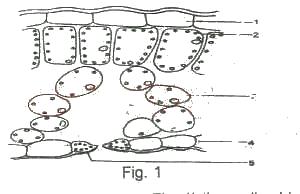A) mitochondria
B) ribosomes
C) endoplasmic reticulum
D) golgi bodies
Show Answer
The correct answer is A .
A) mammals
B) reptiles
C) aves
D) amphibians
Show Answer
The correct answer is A .
A) Bowmans capsule
B) Urethra
C) Ureter
D) Loop of henle
Show Answer
The correct answer is D .
A) last upper premolar and the first lower molar
B) last upper molar and the last lower molar
C) first upper premolar and the lower molar
D) first upper molar and the first lower molar
Show Answer
The correct answer is A .
The growth of mucor on a piece of bread is?
Options:A) scavenging
B) commensalism
C) autotrophism
D) saprophytism
Show Answer
The correct answer is D .
A) wind generator
B) solar panels
C) nuclear energy
D) hydroelectric power
Show Answer
The correct answer is C .

In the figure above the cell which controls the opening and closing of stomatal pore is
Options:A) 1
B) 2
C) 3
D) 4
E) 5
Show Answer
The correct answer is E .
A) mixed with sugar solution in the cold
B) warmed or heated by itself
C) mixed with reducing sugar in the cold
D) warmed or heated with complex solution
E) warmed with a solution of reducing sugar
Show Answer
The correct answer is E .
A) vitamin E
B) Vitamin A
C) Vitamin K
D) Vitamin C
Show Answer
The correct answer is B .
A) Part of the cotyledon
B) Part of the endosperm
C) A miniature shoot
D) Structure near the micropyle
E) Structure opposite the hilum
Show Answer
The correct answer is C .